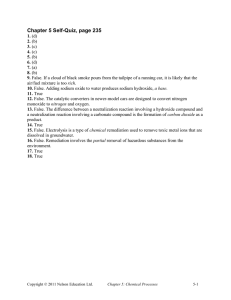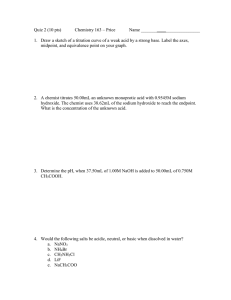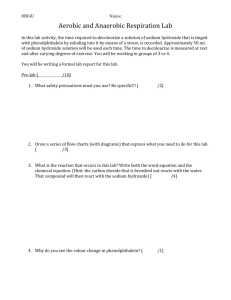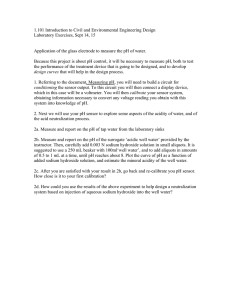Sodium Hydroxide - KODAK Motion Picture Film
advertisement
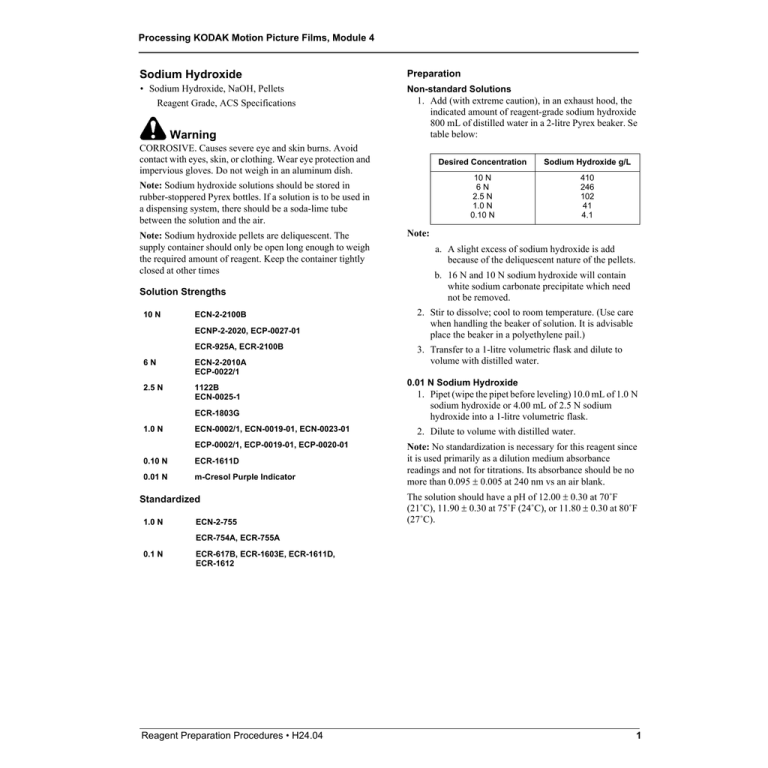
Processing KODAK Motion Picture Films, Module 4 Sodium Hydroxide Preparation • Sodium Hydroxide, NaOH, Pellets Reagent Grade, ACS Specifications Non-standard Solutions Warning 1. Add (with extreme caution), in an exhaust hood, the indicated amount of reagent-grade sodium hydroxide 800 mL of distilled water in a 2-litre Pyrex beaker. Se table below: CORROSIVE. Causes severe eye and skin burns. Avoid contact with eyes, skin, or clothing. Wear eye protection and impervious gloves. Do not weigh in an aluminum dish. Note: Sodium hydroxide solutions should be stored in rubber-stoppered Pyrex bottles. If a solution is to be used in a dispensing system, there should be a soda-lime tube between the solution and the air. Note: Sodium hydroxide pellets are deliquescent. The supply container should only be open long enough to weigh the required amount of reagent. Keep the container tightly closed at other times Solution Strengths 10 N ECN-2-2100B ECNP-2-2020, ECP-0027-01 ECR-925A, ECR-2100B 6N ECN-2-2010A ECP-0022/1 2.5 N 1122B ECN-0025-1 ECR-1803G 1.0 N ECN-0002/1, ECN-0019-01, ECN-0023-01 ECP-0002/1, ECP-0019-01, ECP-0020-01 0.10 N ECR-1611D 0.01 N m-Cresol Purple Indicator Standardized 1.0 N ECN-2-755 Desired Concentration Sodium Hydroxide g/L 10 N 6N 2.5 N 1.0 N 0.10 N 410 246 102 41 4.1 Note: a. A slight excess of sodium hydroxide is add because of the deliquescent nature of the pellets. b. 16 N and 10 N sodium hydroxide will contain white sodium carbonate precipitate which need not be removed. 2. Stir to dissolve; cool to room temperature. (Use care when handling the beaker of solution. It is advisable place the beaker in a polyethylene pail.) 3. Transfer to a 1-litre volumetric flask and dilute to volume with distilled water. 0.01 N Sodium Hydroxide 1. Pipet (wipe the pipet before leveling) 10.0 mL of 1.0 N sodium hydroxide or 4.00 mL of 2.5 N sodium hydroxide into a 1-litre volumetric flask. 2. Dilute to volume with distilled water. Note: No standardization is necessary for this reagent since it is used primarily as a dilution medium absorbance readings and not for titrations. Its absorbance should be no more than 0.095 ± 0.005 at 240 nm vs an air blank. The solution should have a pH of 12.00 ± 0.30 at 70˚F (21˚C), 11.90 ± 0.30 at 75˚F (24˚C), or 11.80 ± 0.30 at 80˚F (27˚C). ECR-754A, ECR-755A 0.1 N ECR-617B, ECR-1603E, ECR-1611D, ECR-1612 Reagent Preparation Procedures • H24.04 1 Processing KODAK Motion Picture Films, Module 4 Standardization Prepare the approximate concentration according to the ion (non-standardized solutions) and perform standardization procedure. See Reagent Preparation for: • Potassium Hydrogen Phthalate NIST Acid/Base Primary Standard SRM-84j (or subsequent lot of SRM-84) 8. If possible, use a potentiometric titration rather than visual. Use a pH indicator electrode and a calomel reference electrode such as: • CORNING 476024, glass, rugged bulb (US Standard Connector) or equivalent • CORNING 476002, reference, ceramic junction, calomel, or equivalent (Filled with 3.5 N potassium chloride solution) • Phenolphthalein Indicator Alternative Method Preferred Method 0.01 N Sodium Hydroxide (standardized to 4 decimal places) 0.01 N Sodium Hydroxide (standardized to 4 decimal places) 1. Weigh the indicated amount of NIST potassium hydrogen phthalate (SRM-84j) to the nearest 0.1 mg. Record the weight and place the standard in a 125 mL Erlenmeyer flask. Desired Sodium Hydroxide Normality, N Weight of Potassium Hydrogen Phthalate SRM-84j 1 0.1 4g 0.4 g 1. Pipet (wipe the pipet before leveling) 100.0 mL of standardized 1 N sodium hydroxide into a 1-litre volumetric flask. 2. Dilute to volume with distilled water. 2. Dissolve the sample in 50 to 75 mL of distilled water, stirring on a magnetic stirrer. 3. Add 3 drops of phenolphthalein indicator. 4. Using a 25 mL buret, titrate with the sodium hydroxide being standardized. The end point is indicated by a pink color persists for 30 seconds. 5. Calculations: N NaOH = (g KHC8H4O4)(1000) = (mL NaOH)(eq wt KHC8H4O4K) (g KHC8H4O4)(1000) (mL NaOH)(204.2) = 4.897(g KHC8H4O4) (mL NaOH) 6. Repeat the standardization on two more portions of NIST potassium hydrogen phthalate. 7. To decide whether to accept the reagent or adjust it, see Method IA, Figure 1, “Sequential Analysis for Standardization of Reagents.” Reagent Preparation Procedures • H24.04 2
